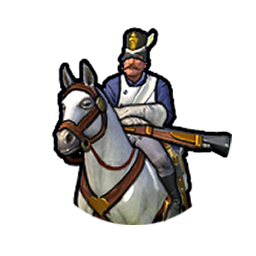Cavalry terminology gets really confusing from the Renaissance on, because, as said, the same terms were used through several of the Civ 'Eras'. BUT what those terms were referring to changed in both function and appearance, so that representing them in Civ gets very tricky.
Let me take them in rough chronological order:
Reiters first appear in the records about 1546, and they are Light Cavalry - men armed like a knight ( or Gendarme) with lance and sword but on smaller horses and with less (but never without any) armor. With a very few years they threw away the lances and adopted the new pistols (first appearance, about 1550), so that they became pistol-firing cavalry armored with a cuirass and helmet.
At about the same time the Harquebussier was developed in France as a similarly-armored man on a lighter horse than a Knight but armed with a smaller arquebus - the first 'carbine', in matchlock form.
Within a century, both Reiters and Harquebussiers were being referred to simply a "Horse", were armored with metal or leather breastplates, helmets, and carried swords. pistols, carbines, or any combination depending on how much money was available to equip them.
Technically, Gustaphus Adolphus' cavalry in the 1630s and 40s were all Harquebussiers, but they carried neither pistol nor harquebuss, nor did they wear metal armor - they charged at speed with swords in a tight formation, so that from that time the terms Reiter and Harquebussier stop having any real meaning.
The first Dragoons appeared about 70 years after the first Harquebussiers or Reiters (in 1618), and from the beginning were not regarded as 'cavalry' but as mounted infantrymen armed with full-sized arquebus or matchlock muskets. Because they used whatever horses were left over after the 'real' cavalry got theirs, they were cheap to form and maintain, and so were used for all the Light Cavalry duties that the older light cavalry had gotten too heavy to perform - no dragoons ever wore any armor or carried lances, and originally weren't even expected to fight on horseback, and certainly not to charge anybody. However, the longer they stayed on horses, the more they disliked getting off of them, so that within a little over a century, Dragoons were 'medium' cavalry and charging the enemy sword in hand. The British Army even invented Heavy Dragoons that, although not armored, were big men on big horses able to fight it out with enemy Cuirassiers.
Speaking of whom. The term Cuirassier appears in the mid- 17th century to describe those few Harquebussiers/Horse who were still wearing 'real' armor (metal breast and back plates and sometimes helmets) instead of leather or thick wool coats. For instance, the French Army by 1690 had 28 regiments of 'Horse' (unarmored) cavalry but only 1 regiment of armored Cuirassiers, the Cuirassiers du Roi - Cuirassiers were Expensive units to form and maintain!
Ulans or Uhlans started out as Lithuanian light cavalry with lances, Hussars as Hungarian light or heavy cavalry with pistols and swords who later dropped the armor in favor of some of the most elaborately decorated uniforms anywhere. Both types were adopted by other armies, and the lance was also adopted by other units, like the British Light Dragoons of the early 19th century and all the German cavalry by the late 19th century - right about the time the chance of actually getting close enough to stick the lance in somebody had become vanishingly small.
So, here's my conclusion for what it's worth:
___________________Renaissance_______Industrial______Modern________Atomic
Light Cavalry.....................Dragoons................Uhlans*.............Armored Car.......Light Armor**
Heavy Cavalry...................Cuirassiers......................................Medium Tanks....Main Battle Tank
* - As said, Hussars, Light Dragoons, Lancers, Chevau Leger were also used but all were similar
** - this represents the heavy armored cars, lighter modern armor like the AMX-13, Strykers, etc, which can be extremely heavily-armed by earlier standards, but remain lighter in armor and faster than the Main Battle and other heavier tanks.
The Helicopter could also be the Atomic Era "light cavalry' Upgrade, since it took over a lot of the scouting and 'pursuit' functions, or it could be a new Low Altitude Air unit, which could have the following Upgrades:
Modern: Air Observation (the really light aircraft like the Fieseler Storch, Piper Cub, or Po-2 used to spot for artillery, liaison communications and short-range reconnaissance)
Atomic: Helicopter Gunship
Information: UAV (armed Drones)

 . In this context specific vehicles as units are also overdatailed when those vehicles were just a part of a more diverse brigade not just armored ones but also infantry or artillery ones.
. In this context specific vehicles as units are also overdatailed when those vehicles were just a part of a more diverse brigade not just armored ones but also infantry or artillery ones.

 )
)